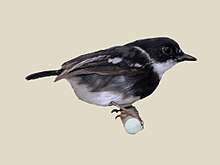Rwenzori batis
| Rwenzori batis | |
|---|---|
 | |
| specimen at Nairobi National Museum | |
| Scientific classification | |
| Kingdom: | Animalia |
| Phylum: | Chordata |
| Class: | Aves |
| Order: | Passeriformes |
| Family: | Platysteiridae |
| Genus: | Batis |
| Species: | B. diops |
| Binomial name | |
| Batis diops | |
The Rwenzori batis (Batis diops) is a species of bird in the wattle-eyes family, Platysteiridae. It is found in the Albertine Rift montane forests above 1,400 m in eastern central Africa.
Description
The Rwenzori batis is a small, active black and white flycatcher-like bird. The upperparts are dark bluish black with a white stripe along the wing and a white loral spot. The underparts are mostly white except for a glossy bluish black breast band, a blacj chin spot and black thighs and grey axillaries. and the belly, . The tail is black with the feathers having white tips and white edges on the outer tail feathers The sexes are similar except that males have yellow eyes and females have been reported to sometimes have orangey red eyes. Juveniles are similar to adults but the plumage has a more rufous cast.[3] The Ruwenzori batis measures 11–12 cm in length, and it weighs 8–15·5 g.[4]
Voice
The territorial call is a slow, low piched whistle has been described as both ventriloqual and eerie. It is repeated with an interval of 2–4 seconds between each whistle.[3]
Distribution and habitat
Eastern central Africa in the Albertine Rift; in the Democratic Republic of Congo it is found from the Rwenzori Mountains in the north to Mount Kabobo in the south, it is also found in western Uganda, Rwanda and Burundi.[4]
The Rwenzori batis occurs in lower elevation montane evergreen forest between 1340m and 3300m above sea level, it is commonest in thick bamboo forest or otherwise closed canopy forest on ridges, suboptimal habitats include mixed forest and scrub.[3]
Habits
The breeding biology and habits of the Rwenzori batis are little known. It is a shy, active bird which is constantly moving but tends to keep hidden in the foliage. It normally forages in mid levels in undergrowth at 2-6m above the ground but also in lower canopy of tall trees. It is insectivorous, flycatching using short flights but most food is probably gleaned from the foliage and twigs. The male appears to regularly feed the incubating or brooding females, the nest and its contents have never been formally described.[3]
Taxonomy
The Rwenzori batis and Margaret's batis probably belong to the superspecies that also contains Cape batis, Forest batis, dark batis and Woodward's batis.[4] The Rwenzori batis appears to replace the Ituri batis at higher atltitudes.[3]
References
- ↑ "Batis diops". The IUCN Red List of Threatened Species. International Union for Conservation of Nature and Natural Resources. Retrieved 2016-11-05.
- ↑ "Batis diops Reichenow, 1903". Integrated Taxonomic Information System (ITIS) (https://www.itis.gov). Retrieved 2016-11-05.
- 1 2 3 4 5 Harris, Tony; Franklin, Kim (2000). Shrikes and Bush-shrikes. Christopher Helm. pp. 320–321. ISBN 0-7136-3861-3.
- 1 2 3 "Ruwenzori Batis (Batis perkeo)". Handbook of the Birds of the World Alive. Lynx Edicions. Retrieved 2016-11-05.
